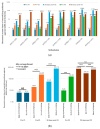Evaluation of Vaccine Strategies among Healthcare Workers during COVID-19 Omicron Outbreak in Taiwan
- PMID: 39340088
- PMCID: PMC11435596
- DOI: 10.3390/vaccines12091057
Evaluation of Vaccine Strategies among Healthcare Workers during COVID-19 Omicron Outbreak in Taiwan
Abstract
Background/objectives: This study aimed to assess the reactogenicity and immunogenicity of various SARS-CoV-2 vaccines and compare their protective effects against COVID-19 among healthcare workers (HCWs) during the Omicron outbreak in Taiwan.
Methods: Conducted from March 2021 to July 2023, this prospective observational study included healthy HCWs without prior COVID-19 immunization. Participants chose between adenovirus-vectored (AstraZeneca), mRNA (Moderna, BioNTech-Pfizer), and protein-based (Medigen, Novavax) vaccines. Blood samples were taken at multiple points to measure neutralizing antibody (nAb) titers, and adverse events (AEs) were recorded via questionnaires.
Results: Of 710 HCWs, 668 (94.1%) completed three doses, and 290 (40.8%) received a fourth dose during the Omicron outbreak. AEs were more common with AstraZeneca and Moderna vaccines, while Medigen caused fewer AEs. Initial nAb titers were highest with Moderna but waned over time regardless of the vaccine. Booster doses significantly increased nAb titers, with the highest levels observed in Moderna BA1 recipients. The fourth dose significantly reduced COVID-19 incidence, with Moderna BA1 being the most effective.
Conclusions: Regular booster doses, especially with mRNA and adjuvant-protein vaccines, effectively enhance nAb levels and reduce infection rates, providing critical protection for frontline HCWs during variant outbreaks.
Keywords: COVID-19; effectiveness; immunogenicity; reactogenicity; vaccine.
Conflict of interest statement
The authors declare no competing interests.
Figures






Similar articles
-
Immunogenicity and safety of a booster dose of a self-amplifying RNA COVID-19 vaccine (ARCT-154) versus BNT162b2 mRNA COVID-19 vaccine: a double-blind, multicentre, randomised, controlled, phase 3, non-inferiority trial.Lancet Infect Dis. 2024 Apr;24(4):351-360. doi: 10.1016/S1473-3099(23)00650-3. Epub 2023 Dec 20. Lancet Infect Dis. 2024. PMID: 38141632 Clinical Trial.
-
Interim safety and immunogenicity of COVID-19 omicron BA.1 variant-containing vaccine in children in the USA: an open-label non-randomised phase 3 trial.Lancet Infect Dis. 2024 Jul;24(7):687-697. doi: 10.1016/S1473-3099(24)00101-4. Epub 2024 Mar 19. Lancet Infect Dis. 2024. PMID: 38518789 Clinical Trial.
-
Magnitude and Duration of Serum Neutralizing Antibody Titers Induced by a Third mRNA COVID-19 Vaccination against Omicron BA.1 in Older Individuals.Infect Chemother. 2024 Mar;56(1):25-36. doi: 10.3947/ic.2023.0057. Epub 2023 Nov 1. Infect Chemother. 2024. PMID: 38014726 Free PMC article.
-
COVID-19 vaccines: comparison of biological, pharmacological characteristics and adverse effects of Pfizer/BioNTech and Moderna Vaccines.Eur Rev Med Pharmacol Sci. 2021 Feb;25(3):1663-1669. doi: 10.26355/eurrev_202102_24877. Eur Rev Med Pharmacol Sci. 2021. PMID: 33629336 Review.
-
The Vaccine Efficacy Against the SARS-CoV-2 Omicron: A Systemic Review and Meta-Analysis.Front Public Health. 2022 Jul 13;10:940956. doi: 10.3389/fpubh.2022.940956. eCollection 2022. Front Public Health. 2022. PMID: 35910897 Free PMC article.
References
-
- WHO Solidarity Trial Vaccines. [(accessed on 29 January 2022)]. Available online: https://www.who.int/emergencies/diseases/novel-coronavirus-2019/global-r....
-
- Ramasamy M.N., Minassian A.M., Ewer K.J., Flaxman A.L., Folegatti P.M., Owens D.R., Voysey M., Aley P.K., Angus B., Babbage G., et al. Safety and Immunogenicity of ChAdOx1 NCoV-19 Vaccine Administered in a Prime-Boost Regimen in Young and Old Adults (COV002): A Single-Blind, Randomised, Controlled, Phase 2/3 Trial. Lancet. 2021;396:1979–1993. doi: 10.1016/s0140-6736(20)32466-1. - DOI - PMC - PubMed
-
- Voysey M., Clemens S.A.C., Madhi S.A., Weckx L.Y., Folegatti P.M., Aley P.K., Angus B., Baillie V.L., Barnabas S.L., Bhorat Q.E., et al. Safety and Efficacy of the ChAdOx1 NCoV-19 Vaccine (AZD1222) against SARS-CoV-2: An Interim Analysis of Four Randomised Controlled Trials in Brazil, South Africa, and the UK. Lancet. 2021;397:99–111. doi: 10.1016/s0140-6736(20)32661-1. - DOI - PMC - PubMed
Grants and funding
LinkOut - more resources
Full Text Sources
Miscellaneous

